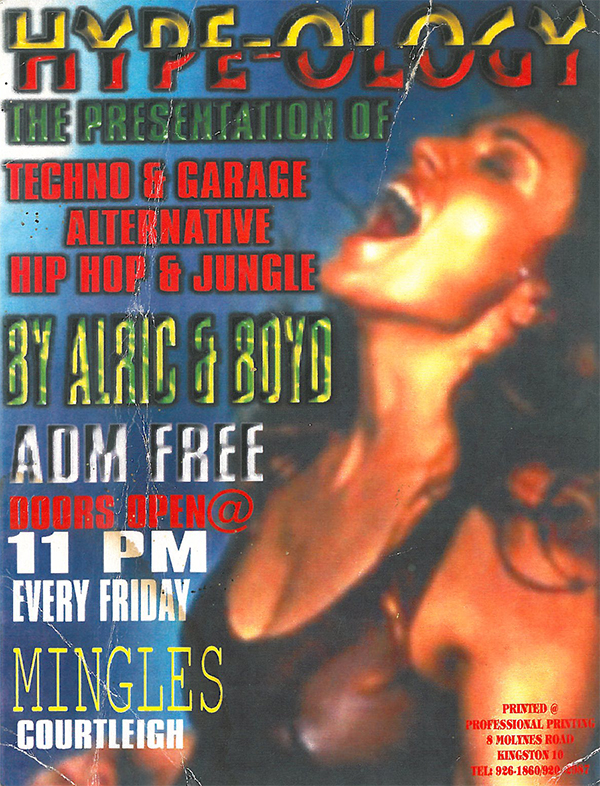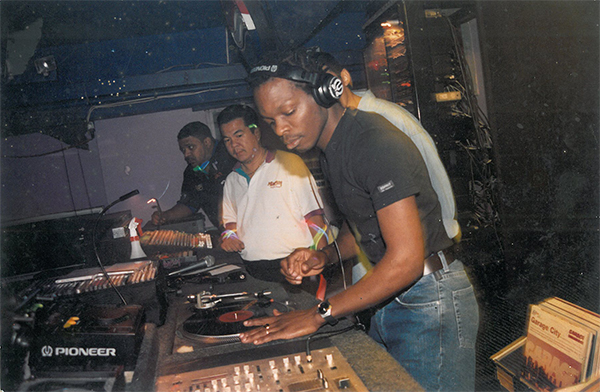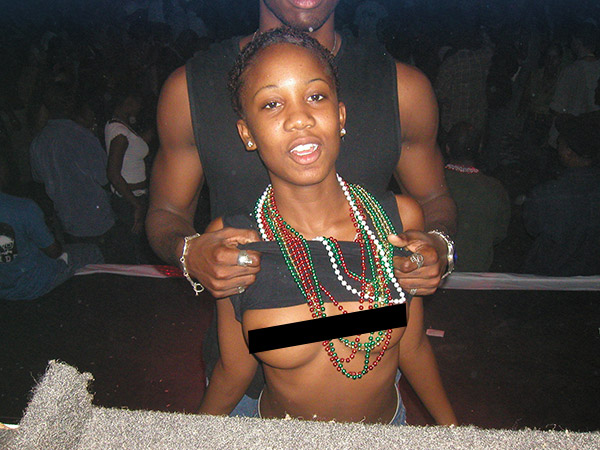Words by Jesse Serwer, Photos and Flyers Courtesy of Alric and Boyd—
Jamaica is known for dancehall, not dance music. Recently, however, we’ve noticed a surge in the number of EDM records coming from the island (as with everyplace else in the world), from dubstep and trap to house. And one needs to look no further than Major Lazer—who made a triumphant return to Kingston in January, four years after flopping there in their worldwide live debut—to see how dancehall and rave culture are intersecting. (If you go back far enough, as our Gabriel Heatwave did here, you already know raving is a direct child of Jamaican sound system culture).
But dance music in Jamaica is nothing new. DJs Alric Anglin and Boyd James, collectively known as Alric and Boyd, have been bringing house, techno and all manner of four-on-the-floor club records (and hip-hop, too) to Jamaica’s nightspots and airwaves for two decades. Known for their long-running FAME FM radio show and their legendary Monday night raves at Kingston nightclub Asylum, the duo (perhaps best known stateside for their role in Max Glazer and Kenny Meez’s Federation Sound) are the godfathers of a small but vibrant Jamaican rave scene that reached its peak in the late ’90s and early ’00s. Fresh off the release of “Seleckta,” their production unit Jamroc’s collaboration with acid-house legend DJ Pierre and Rory of Stone Love fame for Dim Mak Records (read more about that here), Alric and Boyd sat down with LargeUp to break down the story of rave/EDM culture on the island of reggae.
BOYD JAMES: Our music tastes are very eclectic. We have always taken the international side of things and brought it to Jamaica. We don’t only play dancehall and reggae. Yes we do, and we do it well, because we are Jamaican. But I was actually introduced to hip-hop before I was introduced to dancehall. I have one of those lucky families that would send for my brother and I. From when I was 11, 12, every summer we would spend in New York. And I lived in Mount Vernon from 1988 to 1990. I had a cousin who was a big DJ there, and I used to go to the basement parties and so on, and the Tunnel, went to Palladium, Studio 54, and these things blew me away at the time.

Boyd at the controls, at legendary Kingston nightclub Asylum
I was introduced to dance music as well from early out. That helped me to solidify which direction I wanted to go into as a DJ. I started DJing from 1984. In 1986, I linked up with Mixmaster Marvin here and we used to do a thing called Upper Room Sessions in his bedroom. All of the cutting-edge DJs at the time in Jamaica were privy to that circle. Out of that circle came Delano from Renaissance, Chris Goldfinger from BBC Radio 1, and we all shared ideas. The template of the Jamaican style of DJing was made from in that room, which is the cutting, scratching, remixing, playing different forms of music genres, house, hip-hop, dancehall and blending those genres together. I knew from an early age there was an international way of playing different from how Jamaicans played music. I was exposed to a New York side of things, and I brought that at that time. And Marvin brought his style back from England as well. And I knew Alric from way before that.
ALRIC ANGLIN: My DJ career started in ’88. At that time, 1991, I was residenting at three top night clubs in Kingston simultaneously—Illusions, 24K and Godfather’s. In ‘92, Boyd came to me, because we knew each other through martial arts, and said I’ve just come back from New York, I have some wicked tunes that will blow whatever tunes you are playing now out of the water, I’d like a chance to showcase that. I was employed to a soundsystem, Renegade Disco, owned by Andrew Henry. It was through Andrew that I got my training in selection, reading crowds and being able to keep a vibe. I spoke to Andrew and he liked what he heard so he paired Boyd with me to start working in 24K. From then to now, we have been working together, 21 years.
Click here for Part 2 of Alric and Boyd’s oral history of dance/EDM/rave culture in Jamaica





